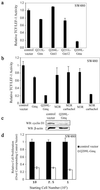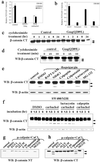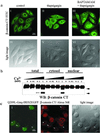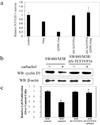Calpain as an effector of the Gq signaling pathway for inhibition of Wnt/beta -catenin-regulated cell proliferation
- PMID: 12239346
- PMCID: PMC130620
- DOI: 10.1073/pnas.202355799
Calpain as an effector of the Gq signaling pathway for inhibition of Wnt/beta -catenin-regulated cell proliferation
Abstract
Signaling pathways interact to integrate and regulate information flow in evoking complex cellular responses. We have studied the mechanisms and consequences of interactions between the Gq and Wnt/beta-catenin pathways. In human colon carcinoma SW480 cells, activation of the Gq pathway inhibits beta-catenin signaling as determined by transcriptional reporter and cell proliferation assays. Ca(2+) release from internal stores results in nuclear export and calpain-mediated degradation of beta-catenin in the cytoplasm. Galphaq does not inhibit the effects of constitutively activated DeltaN-XTCF3-VP16 chimera in SW480 cells. Similarly, in HEK293 cells the Gq pathway suppresses beta-catenin-T cell factor/lymphocyte enhancer factor-1 transcriptional activity induced by Wnt/Frizzled interaction or glycogen synthase kinase-3beta-resistant beta-catenin, but not DeltaN-XTCF3-VP16. We conclude that Gq signaling promotes nuclear export and calpain-mediated degradation of beta-catenin, which therefore contributes to the inhibition of Wnt/beta-catenin pathway.
Figures





Similar articles
-
The calpain system is involved in the constitutive regulation of beta-catenin signaling functions.J Biol Chem. 2005 Jun 10;280(23):22070-80. doi: 10.1074/jbc.M501810200. Epub 2005 Apr 7. J Biol Chem. 2005. PMID: 15817486
-
The human Frizzled 6 (HFz6) acts as a negative regulator of the canonical Wnt. beta-catenin signaling cascade.J Biol Chem. 2004 Apr 9;279(15):14879-88. doi: 10.1074/jbc.M306421200. Epub 2004 Jan 27. J Biol Chem. 2004. PMID: 14747478
-
Cross-talk between Rac1 GTPase and dysregulated Wnt signaling pathway leads to cellular redistribution of beta-catenin and TCF/LEF-mediated transcriptional activation.Oncogene. 2004 Oct 28;23(50):8260-71. doi: 10.1038/sj.onc.1208007. Oncogene. 2004. PMID: 15377999
-
Regulation of beta-catenin signaling in the Wnt pathway.Biochem Biophys Res Commun. 2000 Feb 16;268(2):243-8. doi: 10.1006/bbrc.1999.1860. Biochem Biophys Res Commun. 2000. PMID: 10679188 Review.
-
The promise and perils of Wnt signaling through beta-catenin.Science. 2002 May 31;296(5573):1644-6. doi: 10.1126/science.1071549. Science. 2002. PMID: 12040179 Review.
Cited by
-
Chemokine GPCR signaling inhibits β-catenin during zebrafish axis formation.PLoS Biol. 2012;10(10):e1001403. doi: 10.1371/journal.pbio.1001403. Epub 2012 Oct 9. PLoS Biol. 2012. PMID: 23055828 Free PMC article.
-
Transcriptional mechanisms underlying sensitization of peripheral sensory neurons by granulocyte-/granulocyte-macrophage colony stimulating factors.Mol Pain. 2013 Sep 25;9:48. doi: 10.1186/1744-8069-9-48. Mol Pain. 2013. PMID: 24067145 Free PMC article.
-
Wnt signaling is involved in 6-benzylthioinosine-induced AML cell differentiation.BMC Cancer. 2014 Nov 27;14:886. doi: 10.1186/1471-2407-14-886. BMC Cancer. 2014. PMID: 25428027 Free PMC article.
-
Klotho and aging.Biochim Biophys Acta. 2009 Oct;1790(10):1049-58. doi: 10.1016/j.bbagen.2009.02.005. Epub 2009 Feb 20. Biochim Biophys Acta. 2009. PMID: 19230844 Free PMC article. Review.
-
Targeted inhibition of endothelial calpain delays wound healing by reducing inflammation and angiogenesis.Cell Death Dis. 2020 Jul 14;11(7):533. doi: 10.1038/s41419-020-02737-x. Cell Death Dis. 2020. PMID: 32665543 Free PMC article.
References
-
- Chen J, Iyengar R. Science. 1994;263:1278–1281. - PubMed
-
- Ram P T, Horvath C M, Iyengar R. Science. 2000;287:142–144. - PubMed
-
- Blitzer R D, Connor J H, Brown G P, Wong T, Shenolikar S, Iyengar R, Landau E M. Science. 1998;280:1940–1942. - PubMed
-
- Cowley S, Paterson H, Kemp P, Marshall C J. Cell. 1994;77:841–852. - PubMed
Publication types
MeSH terms
Substances
Grants and funding
LinkOut - more resources
Full Text Sources
Other Literature Sources
Miscellaneous

